The Rushden Echo and Argus,15th May, 1953, transcribed by Gill Hollis
Six Men Provide 70,000 With Their Sunday Joint
Day by day, in a building just out of sight of the busy A6 road at the southern end of Rushden, half a dozen men earn their living by killing four times every hour. In oilskin overalls, they work to a sound background of periodic pistol shots and an electric bone saw.
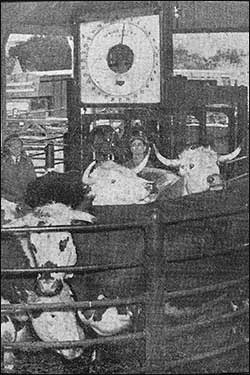 |
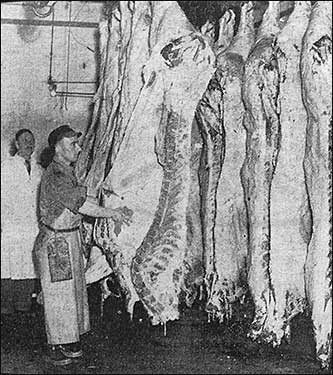 |
|
Wellingborough Cattle Market provides nearly a quarter of the animals at the abattoir. Within a few hours of arriving
and being weighed they go to Rushden, where they are slaughtered next day.
|
20 minutes before this picture was taken, Pat Guinee
saw the animal walk into the slaughter room.
Now he is pushing it into the cooler in two halves.
Next morning it goes to the butcher – and so the
daily round continues.
|
The men, employees at Rushden Abattoir, are busy providing the meat for your table. They know in advance whether the meat on thousands of local tables next Sunday will beef, mutton, or pork. Seventy thousand people in Rushden, Wellingborough, Higham Ferrers, Raunds, Irthlingborough and Bozeat are served by them.
One of 644 Ministry of Food abattoirs in the country, the slaughterhouse was taken over at the beginning of the war. Since that time nearly a quarter of a million animals have passed through.
Until 1952 the peak years were 1940-41-42, when the depot was responsible for supplying meat to British and Allied Service personnel in the area. In those three years alone nearly 62,000 animals were handled.
Last year showed quite a considerable increase over recent ones and 18,001 animals, including 9,858 sheep were killed.
This year the emphasis will be on pigs, and it is expected that about 6,000 – a record number – will be slaughtered.
Killing the animals by painless methods has been reduced to a fine art. On cattle and pigs the men use captive bolt pistols, while sheep are electrocuted. In both cases death is instantaneous and within 20 minutes the biggest of animals can be hanging up “dressed” for the butcher’s shop.
After killing the carcass is bled and hauled up by an electric winch which makes the work of skinning much easier. Next job in the sequence is the removal of stomach and offal, again a task of only a few minutes.
Quick work
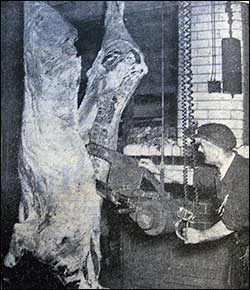 |
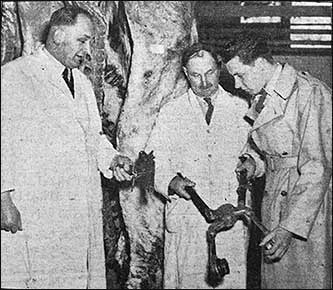 |
|
Making light of heavy work at the abattoir is Harry Windsor of Wymington, who is able to cut a carcase in two in a matter of seconds with the aid of an electric saw.
|
Lethal weapons used at the abattoir are displayed by
Mr Fred Dunmore(left) has a captive bolt pistol, used
on beasts and pigs. Mr Noble, the manager, holds the
apparatus for electrocution of sheep.
|
Then comes a real labour saver. An electric saw cuts down the backbone in a matter of seconds and turns the carcass into two sides. Overlooking all these operations is the manager, Mr. F. W. Noble, a Canadian. He sailed over to this country 20 years ago, and since he took over at Rushden in 1943, nearly 200,000 animals have been killed there.
By these methods the depot can handle comfortably 40 beasts or 120-130 pigs or 250 sheep every day. The record day’s output is 60 beasts.
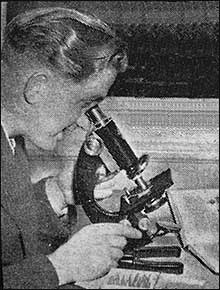 |
|
Mr Hall, Assistant Sanitary Inspector
|
|
It is when the sides of meat are hung alongside the offal that Mr. B. Hall, assistant sanitary inspector to Rushden Urban Council, comes into the picture.
Earlier Mr. Hall examined the live beasts for visual signs of injury or disease. If any such signs were obvious the animal might have been condemned as unfit for human consumption and gone for the making of soap and fertilizers. This time the carcass and offal is examined for disease, tuberculosis being the most prevalent infection.
Last year 39 tons of meat was declared unfit; the record figure was in 1950 when 66 tons was condemned.
A chat with Mr. Hall elicited that an offal can be affected and not the carcass, and vice versa.
Next man on the scene is Mr. Fred Dunmore, local manager for the Midland Wholesale Meat Supply Co., who weighs the meat. His organisation is responsible for maintaining supplies to local butchers.
Medicine is an important by-product of the abattoir. Certain glands from the slaughtered animals, such as the thyroid are removed and placed in cold storage.
|